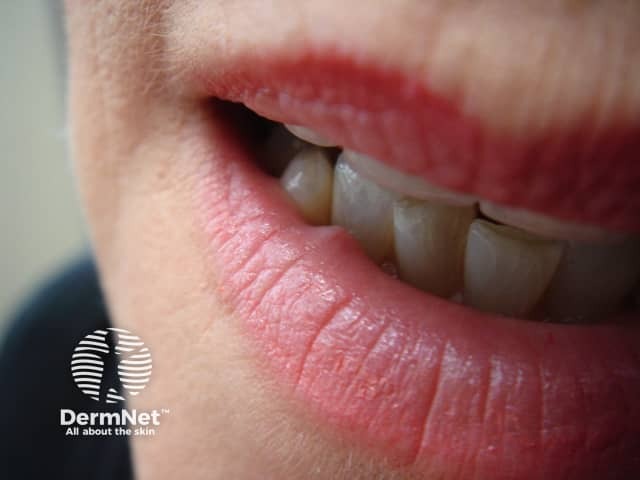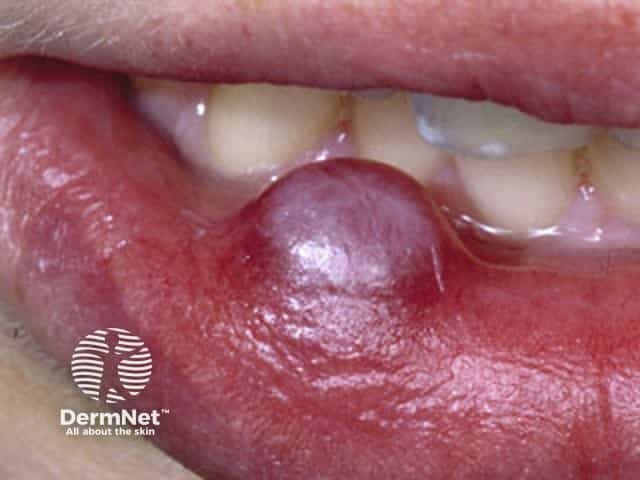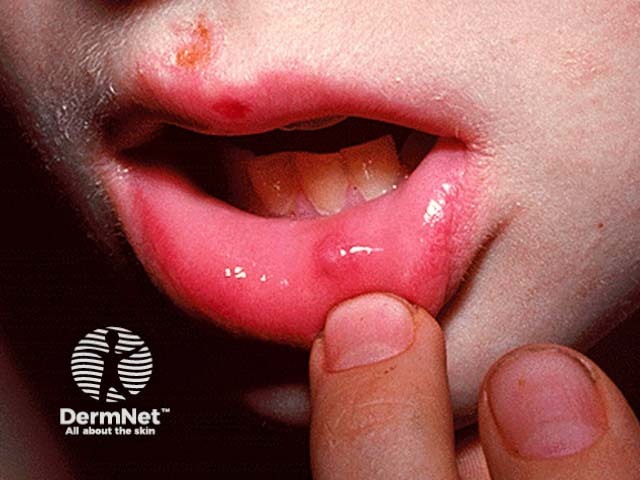Main menu
Common skin conditions

NEWS
Join DermNet PRO
Read more
Quick links
A mucocoele (American spelling ‘mucocele’) is another name for mucous cyst. Mucocoele form when mucus or saliva escapes into surrounding tissues and a lining of granulation or connective tissue is formed to create a smooth, soft round fluid-filled lump. They most commonly occur on the inner surface of the lower lip (75% of cases) but may also appear on the floor of the mouth (in this region they are known as ranulae) or on the gingiva (gums), buccal mucosa (inner lining of the cheeks) and tongue.
Mucocoele tend to be transparent, mucous-filled dome-shaped lesions. Single or multiple lesions may occur and can range from 1-15 mm in diameter. Superficial lesions take on a bluish to translucent colour because of the thin layer of epithelium covering the bluish capillaries. Deeper lesions are usually the same colour as the rest of the lip as they are covered with a thicker layer of tissue. Bleeding into the lesion may cause a bright red colour and may occasionally resemble a haemangioma. Sometimes the surface of the lesion may become white, rough and scaly due to repeated sucking on the lesion.
In most cases of superficial mucocoele lesions tend to persist for several days or weeks, rupture spontaneously (usually while eating), and heal a few days after they rupture. They often recur over and over. The repeated occurrence of mucocoele may lead to a permanent lump on the inner surface of the lip.
Mucocoele are painless but bothersome lesions because people are so aware of the irregularities in the mouth.

Mucocoele of the lip

Mucocoele of the lip

Mucocoele of the lip
Mucocoele are usually the result of trauma in the mouth, which injures the tiny salivary ducts inside of the lip. Injury or rupture of these microscopic excretory ducts leads to an accumulation of mucus inside of the connective tissue of the lip. Lip biting or the sucking action drawing the mucous membranes of the lower lip between the teeth are thought to be common causes. Often the sufferer is not aware of having had an injury.
A biopsy of the mucocoele lesion may be performed to rule out other suspected mucocutaneous diseases.
Superficial mucocoeles usually resolve spontaneously and require no specific treatment. Evening primrose oil has been used with varying degrees of success in a limited number of patients with multiple superficial mucocoeles. However, mucocoeles recurred within a few months after treatment stopped.
If superficial mucocoeles frequently recur and become problematic to the patient, treatment options include surgical removal, creation of a pouch (marsupialization) inside of the lesion, freezing (cryosurgery), laser ablation, and micro-marsupialization. These treatment options are also used to treat deeper lesions.
If adequate and complete surgical excision is achieved with adjacent minor salivary glands removed or transacted, there should be no recurrence of mucocoeles.